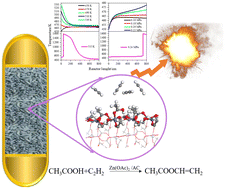A multiscale simulation on the formation mechanism of crotonaldehyde and the influence of operating parameters on the process during the production of vinyl acetate from acetylene†
Abstract
The reaction mechanism of crotonaldehyde, a by-product in the reaction of acetylene to vinyl acetate, was explored by the density functional theory (DFT) method. It is revealed that aldol condensation via acetaldehyde is a possible generation pathway of crotonaldehyde. The kinetic model of the surface-catalyzed reaction process was further refined. CFD simulations of the impact of operating parameters were carried out on a fixed bed reactor for vinyl acetate production by an acetylene process. The effects of feed temperature, pressure, flow rate, and acetylene/acetic acid molar ratio on the reaction process were investigated. The analysis result indicates that small increases in feed temperature and pressure cause uneven temperature distribution in the axial direction. When the feed temperature exceeds 535 K or the pressure exceeds 0.24 MPa, the reactor has the safety hazard of temperature runaway or even explosion. This work provides a theoretical and technical basis for accident prevention and safe long-term operation of petrochemical equipment.



 Please wait while we load your content...
Please wait while we load your content...